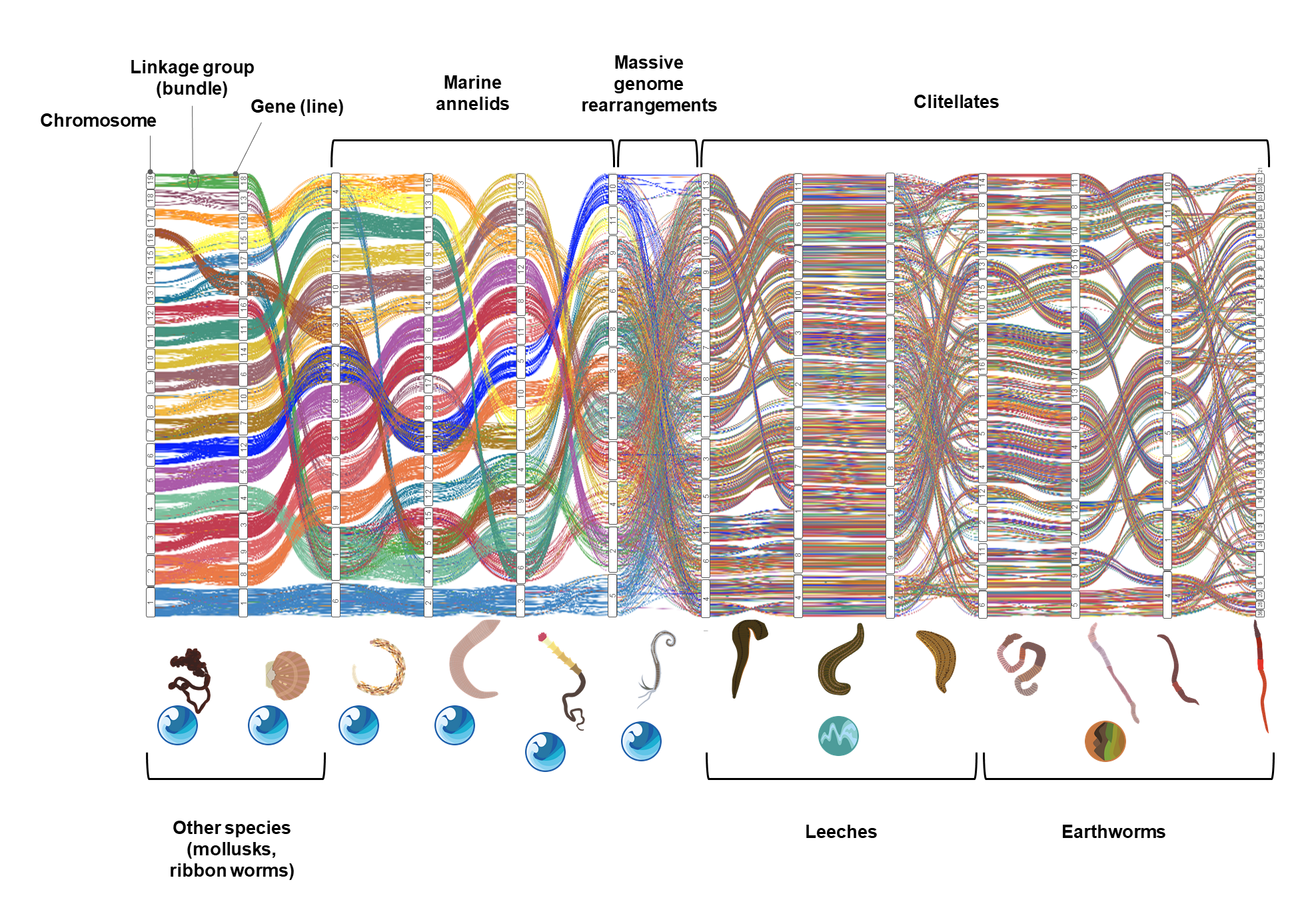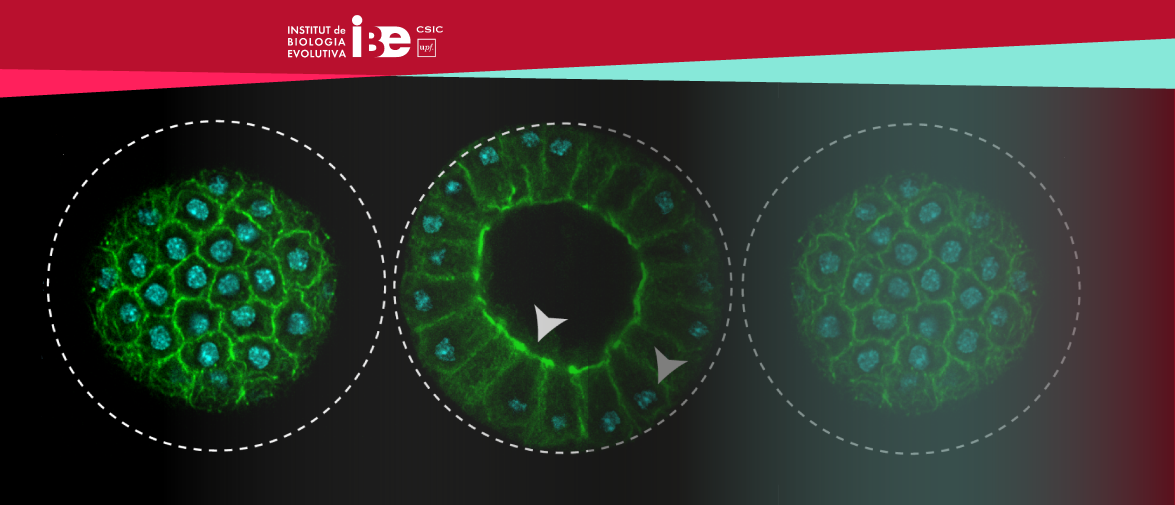Institut de Biologia Evolutiva - CSIC UPF
Las lombrices de tierra revelan un mecanismo evolutivo que desafiaría a Darwin

En 1859, Darwin imaginó la evolución como un proceso lento y gradual, con especies acumulando pequeños cambios a lo largo del tiempo. Pero incluso él se sorprendió al mirar el registro fósil y no encontrar los eslabones perdidos: esas formas intermedias que deberían contar la historia paso a paso, simplemente no estaban. Su explicación fue tan incómoda como inevitable: el registro fósil es, en el fondo, un archivo lleno de páginas arrancadas.
La escasez de formas intermedias llevó a los paleontólogos Stephen Jay Gould y Niles Eldredge a proponer en 1972 una idea provocadora: el equilibrio puntuado. Según esta teoría, las especies no cambian lentamente, sino que permanecen estables durante millones de años y luego, de repente, dan saltos evolutivos breves y radicales. Este modelo explicaría por qué el registro fósil parece tan “silencioso” entre especies: los grandes cambios ocurrirían de forma abrupta y en poblaciones pequeñas y aisladas, lejos del radar paleontológico. Aunque algunos fósiles respaldan este patrón, la comunidad científica sigue dividida: ¿estamos ante una regla de la evolución o una excepción vistosa?
Ahora un equipo de investigación liderado por el Instituto de Biología Evolutiva (IBE), un centro mixto del Consejo Superior de Investigaciones Científicas (CSIC) y la Universidad Pompeu Fabra (UPF), apunta por primera vez a un mecanismo de reorganización genómica rápida y masiva que pudo intervenir en la transición de los animales de los océanos a la tierra, hace 200 m.a. El equipo ha demostrado que los anélidos marinos (los gusanos) reorganizaron su genoma de arriba a abajo, dejándolo irreconocible, al abandonar los océanos y pisar tierra firme. Las observaciones son consistentes con un modelo de equilibrio puntuado, y apuntarían a que cambios abruptos en el genoma – y no solamente graduales – pudieron intervenir en la adaptación de los animales estudiados a ambientes terrestres. El mecanismo genético identificado podría transformar nuestra concepción de la evolución de los animales y sacudir las leyes de la evolución de los genomas que se conocen hasta ahora.
Una librería de genomas invertebrados sin precedentes
El equipo ha secuenciado por primera vez el genoma de alta calidad de varias lombrices de tierra, y los ha comparado con los de otras especies de anélidos cercanas (sanguijuelas y anélidos marinos, o poliquetos). La precisión ha sido la misma con la que se secuencian los genomas humanos, con la particularidad de que se partía sin referencia alguna para las especies estudiadas. La ausencia de genomas completos había impedido hasta ahora el estudio de patrones y características a nivel cromosómico para muchas especies, reduciendo la investigación a fenómenos a menor escala – estudios poblacionales en un puñado de genes, frente a cambios macroevolutivos a nivel de genoma completo.
Después de armar cada uno de los rompecabezas genómicos, el equipo ha conseguido viajar en el tiempo con gran precisión hasta hace más de 200 m.a, cuando vivieron los ancestros de las especies secuenciadas. “Se trata de un episodio evolutivo esencial para la vida en el planeta, puesto que muchas especies, como los gusanos o los vertebrados, que vivían en el océano, pisaron entonces por primera vez tierra firme”, comenta Rosa Fernández, investigadora principal del grupo de Filogenómica y Evolución de Genomas Animales (Metazoa Phylogenomics and Genome Evolution Lab) en el IBE.
El análisis de estos genomas ha revelado un resultado inesperado: las transformaciones genómicas de los anélidos no sucedieron de forma gradual, como predice la teoría neodarwinista, sino en explosiones puntuales de profunda remodelación genética. “La enorme reorganización de los genomas observada en los gusanos al pasar del océano a tierra firme no puede ser explicada con el mecanismo parsimonioso que propone Darwin; nuestras observaciones resuenan mucho más con la teoría de Gould y Eldredge de la evolución puntuada”, añade Fernández.

Abajo: representación del Árbol de la Vida de los anélidos que muestra la posición de las especies incluidas en este estudio. Arriba: organización genómica en anélidos marinos y clitelados, con énfasis en las grandes reorganizaciones genómicas entre ambas líneas evolutivas. Créditos de la figura: Rosa Fernández. Créditos de los datos: Carlos Vargas-Chávez. Créditos de las siluetas: Gemma I. Martínez-Redondo.
Un radical mecanismo genético que aportaría respuestas evolutivas
El equipo ha descubierto que los gusanos de mar rompieron su genoma en mil pedazos para volver a construirlo de otra forma y continuar su legado evolutivo en la tierra. Este fenómeno desafía los modelos de evolución de genomas conocidos hasta ahora puesto que, si observamos casi cualquier especie - desde una esponja hasta un coral o un mamífero -, muchos de ellos conservan su estructura genómica casi a la perfección. "Todo el genoma de los gusanos de mar se rompió y luego se reorganizó de forma completamente aleatoria en muy poco tiempo en la escala evolutiva", dice Fernández. "Hice que mi equipo repitiera el análisis mil veces, porque no me lo podía creer".
La clave de por qué esta rotura tan drástica no resultó en extinción puede estar en la estructura 3D del genoma. El equipo de Fernández ha descubierto que los cromosomas de estos gusanos modernos son mucho más flexibles que los de los vertebrados y otros organismos modelo. Gracias a esta flexibilidad, es posible que genes que están en distintas partes del genoma pudieran cambiar de lugar y seguir funcionando juntos.
Los grandes cambios en el ADN pudieron ayudar a los gusanos a adaptarse rápidamente a la vida en la tierra, reorganizando sus genes para responder mejor a nuevos desafíos como la respiración o la exposición a la luz solar. El estudio sugiere que estos reajustes no solo movieron genes, sino que también unieron fragmentos antes separados, creando nuevas “quimeras genéticas” que habrían impulsado su evolución. “Podría parecer que ese desorden encerraría la extinción del linaje, pero puede que algunas especies basaran su éxito evolutivo en ese superpoder”, comenta Fernández.
Las observaciones del estudio son consistentes con un modelo de equilibrio puntuado, en el que se observa un estallido de cambios genómicos en un corto período después de un largo período de estabilidad. Sin embargo, la ausencia de datos experimentales que confirmen o desmientan - en este caso, fósiles de 200 m.a. de antigüedad - dificulta la validación de esta teoría.
El desorden cromosómico: ¿problema o solución?
El estudio apunta a que conservar la estructura genómica a nivel lineal - es decir, que los genes estén más o menos en el mismo sitio en especies diferentes - quizá no sea tan esencial como se creía. “De hecho, la estabilidad podría ser la excepción y no la regla en los animales, que podrían beneficiarse de un genoma más fluido”, comenta Fernández.
Este fenómeno de reorganización extrema genética se había observado anteriormente en la progresión del cáncer en humanos. Bajo el término cromoanagénesis se agrupan varios mecanismos de rotura y reorganización de cromosomas en células cancerosas, donde se aprecian cambios similares a los observados en las lombrices de tierra. La única diferencia es que mientras en los gusanos estas roturas y reorganizaciones genómicas son toleradas, en humanos dan lugar a enfermedades. Los resultados de este estudio abren la puerta a comprender mejor la potencia de este radical mecanismo genómico con implicaciones para la salud humana.
El estudio, además, ha agitado uno de los debates científicos más vívidos de nuestro tiempo. “Ambas visiones, la de Darwin y la de Gould, son compatibles y complementarias. Mientras que el neodarwinismo explica a la perfección la evolución de las poblaciones, aún no ha conseguido explicar algunos episodios excepcionales y cruciales de la historia de la vida en la Tierra, como la explosión de la vida animal en los océanos primero, hace más de 500 millones de años, o la transición de la vida de los océanos a la tierra, hace 200 en el caso de las lombrices de tierra”, apunta Fernández. “Aquí es donde la teoría del equilibrio puntuado podría aportar respuestas”.
En el futuro, una mayor investigación de la arquitectura genómica de invertebrados menos estudiados podría arrojar luz sobre los mecanismos genómicos que vertebran la evolución de las especies. “Hay una gran diversidad que desconocemos, escondida en los invertebrados, y su estudio podría aportarnos nuevos descubrimientos inesperados sobre la diversidad y plasticidad de la organización genómica, y llevarnos a romper dogmas sobre cómo creemos que están organizados los genomas”, concluye Fernández.
El estudio ha contado con la colaboración de personal investigador de la Universitat Autònoma de Barcelona, Trinity College, la Universidad Complutense de Madrid, la University of Köln y la Université Libre de Bruxelles.
El estudio ha recibido el soporte de la ayuda SEA2LAND (Starting Grant financiada por el European Research Council), así como del Catalan Biogenome Project, que financió la secuenciación de uno de los genomas de lombrices.
Artículo referenciado: Vargas-Chávez, C., Benítez-Álvarez, L., Martínez-Redondo, G. I., Álvarez-González, L., Salces-Ortiz, J., Eleftheriadi, K., Escudero, N., Guiglielmoni, N., Flot, J.-F., Novo, M., Ruiz-Herrera, A., McLysaght, A., & Fernández, R. (2025). A punctuated burst of massive genomic rearrangements by chromosome shattering and the origin of non-marine annelids. Nature Ecology and Evolution. https://doi.org/10.1038/s41559-025-02728-1






















